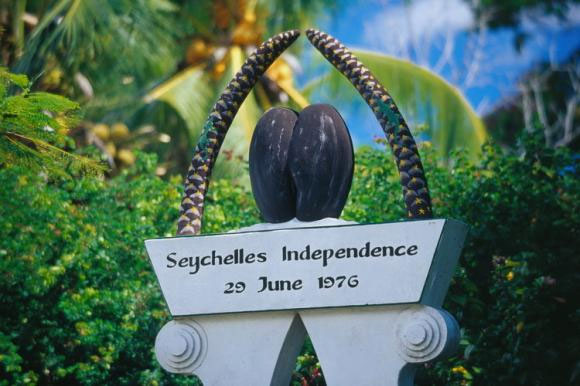Discover the secrets of the world's largest nuts
New invention on how to create the world's largest seed of Coco de Mer sea coconut, "Sychelles treasure" made by a group of German researchers originating from a folk legend in the Seychelles island nation dreamy.
Coco de Mer sea coconut grows only in Vallee de Mai on Praslin Island (southwestern Indian Ocean). On average, a coconut weighs about 23 to 30kg, 25 to 34cm tall and 7 to 10cm long.
The Seychelles island nation, the home of Coco de Mer coconut, is considered the pearl between the Indian Ocean, located off the east coast of Africa, which has intrigued people all over the world because it is a holiday honeymoon of Prince British couple William and Kate Middleton.

Seychelles island - Pearl in the Indian Ocean
Coco de mer's sea coconut seed is the largest and heaviest seed in the world, thought to have originated from trees in the Indian Ocean. Even after this coconut grows on land, local people still believe that: To produce this seed, male and female plants must embrace each other in a stormy night.
How can a tree grow on barren land like this island region can produce a particle with a diameter of up to half a meter and an average weight of about 25kg?

New inventions of scientists focus on how to create the world's largest seed
The new invention by scientists focuses on how to create the world's largest seed of Coco de Mer sea coconut, the treasure of the Seychelles Republic - also known as the 'clit fruit' by shape. Its strange and unique.
A team of researchers from Darmstadt Technical University in Germany analyzed leaves, stems, flowers and seeds taken from Coco de Mer tree living on Praslin island. The researchers found that Coco de Mer leaves only about a third of the levels of nitrogen and phosphorus commonly found in leaves and other shrubs in Seychelles. In addition, before the old leaves fall, the palm trees draw most of the nutrients from the leaves and recycle them to develop this largest, fruiting fruit. Thus, the nutrients of the plants are less concentrated in the leaves, focusing more on the palm to nourish the growing coconut.
However, it is not the only way to provide nutrition for fruits. The large and pleated leaves show a clear effect of making the water flow down the trunk when it rains. The researchers also discovered that the water carried many nutrients from leaves - dead flowers, pollen, and bird droppings, swept them to the ground around the stump. Therefore, the concentration of nitrogen and phosphorus in the soil from the trunk by 20cm higher than at least 50% in areas 2 meters away.
This discovery is linked to a remarkable event about this palm tree: apparently Coco der Mer is the only palm in the plant world to take care of seedlings after germination. The researchers also found that the seedlings benefit from growing in the dark of their parents, because they can access more nutritious land there.

This new invention also suggests why this coconut's seed is so big.
However, this still does not explain why the seeds of the plant are so large. According to one hypothesis, researchers must return to the extinction of the dinosaurs. About 66 million years ago, the ancestral forms of palm trees could be based on animals to spread their relatively large seeds - but the mechanism was then lost when the fragments of the continental shell split. This includes the Seychelles and the formation of India now and also isolating this palm tree.
This means that the seedlings must adapt to grow in the darkness of the parent plant. Because large seeds contain a good supply of nutrients, the seedlings are provided with this abundant nutrient, and eventually defeat most of the other species in the ecosystem. And to this day, Coco de mer is still the dominant tree species in their development forests.
When a forest is dominated by a single species, competition is no longer a competition between species but a competition between siblings in the same species. This means Coco de Mer palm gradually grows larger and larger seeds by providing seeds with abundant nutrients to increase the chances of survival compared to their brothers. .
However, Coco de Mer palm still has mysteries without answers, such as how their flowers, the world's largest flower, are pollinated. And the folk legend about the male tree uprooting from the ground to embrace the tree during a stormy night to create the seed makes the mystery even more appealing.
- A handful of nuts every day reduces the risk of premature death
- Discover amazing effects of nuts with health
- Nuts have a wonderful health benefit that should be added during Tet
- He may die if exposed to nuts
- Healthy nuts
- Nuts can be put on a diet
- These nuts are extremely good for winter health
- Nuts can help control colon cancer
- Discover secrets from tombs
- The true shape of the nuts and fruits we eat every day before harvest
- Sniffing dogs help owners avoid allergies
- Nuts can prevent colon cancer
 'Fine laughs' - Scary and painful torture in ancient times
'Fine laughs' - Scary and painful torture in ancient times The sequence of numbers 142857 of the Egyptian pyramids is known as the strangest number in the world - Why?
The sequence of numbers 142857 of the Egyptian pyramids is known as the strangest number in the world - Why? History of the iron
History of the iron What is alum?
What is alum? The largest (and most exotic) seed in the world
The largest (and most exotic) seed in the world 